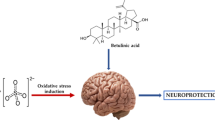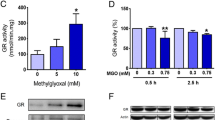Abstract
The aim of this study was to investigate the effect of Krebs cycle intermediates on basal and quinolinic acid (QA)- or iron-induced TBARS production in brain membranes. Oxaloacetate, citrate, succinate and malate reduced significantly the basal and QA-induced TBARS production. The potency for basal TBARS inhibition was in the order (IC50 is given in parenthesis as mM) citrate (0.37) > oxaloacetate (1.33) = succinate (1.91) >> malate (12.74). α-Ketoglutarate caused an increase in TBARS production without modifying the QA-induced TBARS production. Cyanide (CN−) did not modify the basal or QA-induced TBARS production; however, CN− abolished the antioxidant effects of succinate. QA-induced TBARS production was enhanced by iron ions, and abolished by desferrioxamine (DFO). The intermediates used in this study, except for α-ketoglutarate, prevented iron-induced TBARS production. Oxaloacetate, citrate, α-ketoglutarate and malate, but no succinate and QA, exhibited significantly iron-chelating properties. Only α-ketoglutarate and oxaloacetate protected against hydrogen peroxide-induced deoxyribose degradation, while succinate and malate showed a modest effect against Fe2+/H2O2-induced deoxyribose degradation. Using heat-treated preparations citrate, malate and oxaloacetate protected against basal or QA-induced TBARS production, whereas α-ketoglutarate induced TBARS production. Succinate did not offer protection against basal or QA-induced TBARS production. These results suggest that oxaloacetate, malate, succinate, and citrate are effective antioxidants against basal and iron or QA-induced TBARS production, while α-ketoglutarate stimulates TBARS production. The mechanism through which Krebs cycle intermediates offer protection against TBARS production is distinct depending on the intermediate used. Thus, under pathological conditions such as ischemia, where citrate concentrations vary it can assume an important role as a modulator of oxidative stress associated with such situations.
Similar content being viewed by others
References
M. Sokolowska A. Oleszek L. Wodek (1999) ArticleTitleProtective effect of alpha-ketoacids on the oxidative hemolysis Pol. J. Pharmacol 51 429–434
S. Desagher J. Glowinski J. Premont (1997) ArticleTitlePyruvate protects neurons against hydrogen peroxide-induced toxicity J. Neurosci 17 9060–9067
S. Velvizhi K. B. Dakshayani P. Subramanian (2002) ArticleTitleEffects of α-ketoglutarate on antioxidants and lipid peroxidation products in rats treated with ammonium acetate Nutrition 18 747–750
S. Velvizhi T. Nagalashmi M. Mohamed Essa K. B. Dakshayani P. Subramanian (2002) ArticleTitleEffects of α-ketoglutarate on lipid peroxidation and antioxidant status during chronic ethanol administration in Wistar rats Pol. J. Pharmacol 54 231–236
H. Yamamoto P. V. Mohanan (2003) ArticleTitleEffect of α-ketoglutarate and oxaloacetate on brain mitochondrial DNA damage and seizures induced by kainic acid in mice Toxicol. Lett 143 115–122
R. T. Mallet J. Sun (2003) ArticleTitleAntioxidant properties of myocardial fuels Mol. Cell. Biochem 253 103–111
R. T. Mallet (2000) ArticleTitlePyruvate: Metabolic protector of cardiac performance Proc. Soc. Exp. Biol. Med 223 136–148
R. T. Mallet J. Sun (1999) ArticleTitleMitochondrial metabolism of pyruvate is required for its enhancement of cardiac function and energetics Cardiovasc. Res 42 149–161
M. S. Baker J. M. Gebicki (1986) ArticleTitleThe effect of pH on yields of hydroxyl radicals produced from superoxide by potential biological iron chelators Arch. Biochem. Biophys 246 581–588
H. B. Abrahamson A. B. Rezvani G. Brushmiller (1994) ArticleTitlePhotochemical and spectroscopic studies of complexes of iron (III) with citric acid and other carboxylic acids Inorg. Chimica Acta 226 117–127
C. O. Chiueh H. Miyake M. T. Peng (1993) ArticleTitleRole of dopamine autoxidation, hydroxyl radical generation, and calcium overload in underlying mechanisms involved in MPTP-induced parkinsonism Adv. Neurol 60 251–258
J. M. Gutteridge (1994) ArticleTitleHydroxyl radicals, iron, oxidative stress, and neurodegeneration Ann. NY Acad. Sci 738 201–213
R. Takayanagi K. Takeshige S. Minakami (1980) ArticleTitleNADH- and NADPH-dependent lipid peroxidation in bovine heart submitochondrial particles. Dependence on the rate of electron flow in the respiratory chain and an antioxidant role Biochem. J 192 853–860
A. Bindoli L. Cavallini P. Jocelyn (1982) ArticleTitleMitochondrial lipid peroxidation by cumene hydroperoxide and its prevention by succinate Biochim. Biophys. Acta 681 496–503
L. Cavallini M. Valente A. Bindoli (1984) ArticleTitleComparison of cumene hydroperoxide – and NADPH/ Fe3+/ADP-induced lipid peroxidation in heart and liver submitochondrial particles. Mechanisms of protection by succinate Biochim. Biophys. Acta 795 466–472
Y. Hatefi W. G. Hanstein (1970) ArticleTitleLipid oxidation in biolo gical membranes .1. Lipid oxidation in submitochondrial particles and microsomes induced by chaotropic agents Arch. Biochem. Biophys 138 73–86
K. Takeshige S. Minakami (1975) ArticleTitleReduced nicotinamide adenine-dinucleotide phosphate-dependent lipid peroxidation by beef heart submitochondrial particles J. Biochem 77 1067–1073
A. Vianello F. Macri L. Cavallini A. Bindoli (1986) ArticleTitleInduction of lipid peroxidation in Soybean mitochondria and protection by respiratory substrates J. Plant Physiol 125 217–224
G. Ghisleni L. O. Porciúncula H. Cimarostia J. B. T. Rocha C. G. Salbego D. O. Souza (2003) ArticleTitleDiphenyl diselenide protects rat hippocampal slices submitted to oxygen–glucose deprivation and diminishes inducible nitric oxide synthase immunocontent Brain Res 986 196–199
M. Oubidar M. Boquillon C. Marie L. Schreiber J. Bralet (1994) ArticleTitleIschemia-induced brain iron delocalization: Effect of iron chelators Free Radic. Biol. Med 16 861–867
L. O. Porciúncula J. B. T. Rocha H. Cimarosti L. Vinade G. Ghisleni C. G. Salbego D. O. Souza (2003) ArticleTitleNeuroprotective effect of ebselen on rat hippocampal slices submitted to oxygen-glucose deprivation: correlation with immunocontent of inducible nitric oxide synthase Neurosci. Lett 346 101–104
S. Hoyer C. Krier (1986) ArticleTitleIschemia and the aging brain. Studies on glucose and energy metabolism in rat cerebral cortex Neurobiol. Aging 7 23–29
J. Folbergrová B. Ljunggren K. Norberg B. K. Siesjö (1974) ArticleTitleInfluence of complete ischemia on glycolytic metabolites, citric acid cycle intermediates, and associated amino acids in the rat cerebral cortex Brain Res 80 265–279
L. V. Medvedeva T. N. Popova V. G. Artyukhov L. V. Matasova R. V. Akatova (2002) ArticleTitleOxidative status and distribution of NADP-dependent isocitrate dehydrogenase and aconitate hydratase in rat cardiomyocytes under normal conditions and during ischemia Bull. Exp. Biol. Med 134 130–134
J. I. Rossato G. Zeni C. F. Mello M. A. Rubin J. B. T. Rocha (2002) ArticleTitleEbselen blocks the quinolinic acid-induced production of thiobarbituric acid reactive species but does not prevent the behavioral alterations produced by intra-striatal quinolinic acid administration in the rat Neurosci. Lett 318 137–140
R. Schwarz E. Okuno R. J. White E. D. Bird W. O. Whetsell SuffixJr. (1988) ArticleTitle3-Hydroxyantranilat oxygenase activity is increased in the brain of Huntington disease victims Proc. Natl. Acad. Sci. USA 85 4079–4081
M. P. Heyes K. Saito J. S. Crowley L. E. Davis M. A. Demitrack M. Der L. A. Dilling J. Elia M. J. P. Kruesi A. Lackner S. A. Larsen K. Lee H. L. Leonard S. P. Markey A. Martin S. Milstein M. M. Mouradian M. R. Pranzatell B. J. Quearry A. Salazar M. Smith S. E. Strauss T. Sunderland S. W. Swedo W. W. Tourtellotte (1992) ArticleTitleQuinolinic acid and kynurenine pathway metabolism in inflammatory and non-inflammatory neurological disease Brain 115 1249–1273
M. P. Heyes (1996) ArticleTitleThe kynurenine pathway and neurological disease. Therapeutic strategies Adv. Exp. Med. Biol 398 125–129
A. Santamaría C. Ríos (1993) ArticleTitleMK-801, an N-methyl-D-aspartate receptor antagonist, blocks quinolinic acid-induced lipid peroxidation in rat corpus striatum Neurosci. Lett 159 51–54
J. Cabrera R. J. Reiter D. Tan W. Qi R. M. Sainz J. C. Mayo J. J. Garcia S. J. Kim G. El- Sokkary (2000) ArticleTitleMelatonin reduces oxidative neurotoxicity due to quinolinic acid: In vitro and in vivo findings Neuropharmacology 39 507–514
L. O. Porciúncula J. B. T. Rocha C. R. Boeck D. Vendite D. O. Souza (2001) ArticleTitleEbselen prevents excitotoxicity provoked by glutamate in rat cerebellar granule neurons Neurosci. Lett 299 217–220
A. Santamaria R. Salvatierra-Sanchez B. Vazquez-Roman D. Santiago-Lopez J. Villeda-Hernandez S. Galvan-Arzates M. E. Jiménez-Capdeville S. F. Ali (2003) ArticleTitleProtective effects of the antioxidant selenium on quinolinic acid-induced neurotoxicity in rats: in vitro and in vivo studies J. Neurochem 86 479–488
C. Rios A. Santamaria (1991) ArticleTitleQuinolinic acid is a potent lipid peroxidant in rat brain homogenates Neurochem. Res 16 1139–1141
J. I. Rossato L. A. Ketzer F. B. Centurião S. J. N. Silva D. S. Ludtke G. Zeni A. L. Braga M. A. Rubin J. B. T. Rocha (2002) ArticleTitleAntioxidant properties of new chalcogenides against lipid peroxidation in rat brain Neurochem. Res 27 297–303
N. A. V. Bellé G. D. Dalmolin G. Fonini M. A. Rubim J. B. T. Rocha (2004) ArticleTitlePolyamines reduces lipid peroxidation induced by different pro-oxidant agents Brain Res 1008 245–251
S. Stípek F. Stastný J. Pláteník J. Crkovská T. Zima (1997) ArticleTitleThe effect of quinolinate on rat brain lipid peroxidation is dependent on iron Neurochemistry 30 233–237
J. Platenik P. Stopka M. Vejrazka S. Stipek (2001) ArticleTitleQuinolinic acid–iron(II) complexes: Slow autoxidation, but enhanced hydroxyl radical production in the Fenton reaction Free Radic. Res 34 445–459
J. M. Braughler L. A. Duncan R. L. Chase (1986) ArticleTitleThe involvement of iron in lipid peroxidation. Importance of ferric to ferrous ratios in initiation J. Biol. Chem 261 10282–10289
G. Minotti S. D. Aust (1992) ArticleTitleRedox cycling of iron and lipid peroxidation Lipids 27 219–226
M. Oubidar M. Boquillon M. Christine B. Christine A. Beley J. Bralet (1996) ArticleTitleEffect of intracellular iron loading on lipid peroxidation of brain slices Free Radic. Biol. Med 21 763–769
J. M. Braughler E. D. Hall (1989) ArticleTitleCentral nervous system trauma and stroke. I. Biochemical considerations for oxygen radical formation and lipid peroxidation Free Radic. Biol. Med 6 289–301
C. Bromont C. Marie J. Bralet (1989) ArticleTitleIncreased lipid peroxidation in vulnerable brain regions after transient forebrain ischemia in rats Stroke 20 918–924
G. S. Krause K. M. Joyce N. R. Nayini C. L. Zonia A. M. Garritano T. J. Hoehner A. T. Evans R. J. Indreri R. R. Huang S. D. Aust B. C. White (1985) ArticleTitleCardiac arrest and resuscitation: Brain iron delocalization during reperfusion Ann. Emerg. Med 14 1037–1043
H. Ohkawa N. Ohishi K. Yagi (1979) ArticleTitleAssay for lipid peroxides in animal tissues by thiobarbituric acid reaction Anal. Biochem 95 351–358
J. M. C. Gutteridge (1981) ArticleTitleThiobarbituric acid-reactivity following iron-dependent free-radical damage to amino acids and carbohydrates FEBS Lett 128 343–346
B. Halliwell J. M. C. Gutteridge (1981) ArticleTitleFormation of a thiobarbituric-acid-reactive substance from deoxyribose in the presence of iron salts: The role of superoxide and hydroxyl radicals FEBS Lett 128 347–352
G. Minotti S. D. Aust (1987) ArticleTitleAn investigation into the mechanism of citrate–Fe2+-dependent lipid peroxidation Free Radic. Biol. Med 3 379–387
M. C. Jacqes-Silva C. W. Nogueira L. C. Broch E. M. M. Flores J. B. T. Rocha (2001) ArticleTitleDiphenyl disselenides and ascorbic acid changes deposition of selenium and ascorbic acid in brain of mice Phamacol Toxicol 44 119–125
C. C. Chiueh (2001) ArticleTitleIron overload, oxidative stress, and axonal dystrophy in brain disorders Pediatr. Neurol 25 138–147
O. I. Aruoma M. Grootveld B. Halliwell (1987) ArticleTitleThe role of iron in ascorbate-dependent deoxyribose degradation. Evidence consistent with a site-specific hydroxyl radical generation caused by iron ions bound to the deoxyribose molecule J. Inorg. Biochem 29 289–299
A. A. Caro A. T. Cederbaum (2004) ArticleTitleAntioxidant properties of S-adenosyl-L-methionine in Fe2+-initiated oxidations Free Radic. Biol. Med 36 1303–1316
L. X. Tang J. L. Yang X. Shen (1997) ArticleTitleEffects of additional iron-chelators on Fe2+-initiated lipid peroxidation: Evidence to support the Fe2+...Fe3+ complex as the initiator J. Inorg. Biochem 68 265–272
S. Y. Quian G. R. Buettner (1999) ArticleTitleIron and dioxygen chemistry is an important route to initiation of biological free radical oxidations: An electron paramagnetic resonance spin trapping study Free Radic. Biol. Med 26 1447–1456
X. Huang J. Dai J. Fournier A. M. Ali Q. Zhang K. Frenkel (2002) ArticleTitleFerrous ion autoxidation and its chelation in iron-loaded human liver HepG2 cells Free Radic. Biol. Med 32 84–92
J. M. C. Gutteridge (1991) ArticleTitleHydroxyl radical formation from the auto-reduction of a ferric citrate complex Free Radic. Biol. Med 11 401–406
N. Westergaard T. Banke P. Wahl U. Sonnewald A. Schousboe (1995) ArticleTitleCitrate modulates the regulation by Zn2+ of N-methyl-D-aspartate receptor-mediated channel current and neurotransmiter release Proc. Natl. Acad. Sci. USA 92 3367–3370
Author information
Authors and Affiliations
Corresponding author
Rights and permissions
About this article
Cite this article
Puntel, R.L., Nogueira, C.W. & Rocha, J.B.T. Krebs Cycle Intermediates Modulate Thiobarbituric Acid Reactive Species (TBARS) Production in Rat Brain In Vitro. Neurochem Res 30, 225–235 (2005). https://doi.org/10.1007/s11064-004-2445-7
Accepted:
Issue Date:
DOI: https://doi.org/10.1007/s11064-004-2445-7




